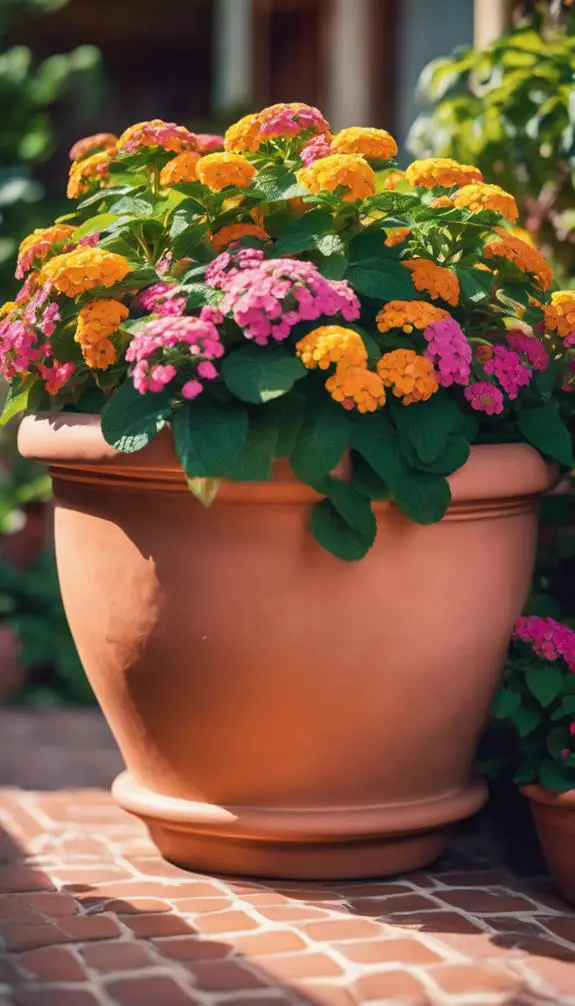You're considering bringing a slice of serenity to your outdoor space, and a backyard greenhouse is the perfect solution. You've got a vision of lush greenery, vibrant flowers, and fresh produce, but where do you start? With so many options available, it can be overwhelming. Should you opt for a cost-effective DIY kit or get creative with repurposed materials? What about innovative designs that maximize natural light and climate control? You're just a few steps away from turning your backyard into a thriving oasis, but first, let's explore the possibilities that'll take your greenhouse from ordinary to extraordinary.
DIY Greenhouse Kits on a Budget

When venturing on a backyard greenhouse project, your wallet doesn't have to take a hit, as cost-effective DIY greenhouse kits can be assembled with minimal financial outlay.
As a DIY enthusiast, you can overcome budget constraints by opting for pre-fabricated kits that cater to your specific needs. These kits usually come with detailed instructions, making it easier for you to assemble the structure without requiring extensive expertise.
By choosing a DIY kit, you'll save on labor costs and still achieve a functional and efficient greenhouse. Look for kits made from durable, weather-resistant materials like polycarbonate or PVC, which can withstand harsh outdoor conditions.
Additionally, consider kits with adjustable frames, allowing you to customize the size and shape of your greenhouse according to your available space.
With a DIY greenhouse kit, you'll be able to create a thriving garden oasis without breaking the bank. By doing it yourself, you'll not only save money but also gain a sense of accomplishment and pride in your handiwork.
Repurposed Materials for Greenhouse

When building a backyard greenhouse, you'll want to ponder repurposing materials to reduce waste and add a personal touch.
You can get creative with items you might otherwise throw away, turning them into functional and eco-friendly components for your greenhouse.
Old Windows Revival
By repurposing old windows, you can create a unique and eco-friendly greenhouse that not only reduces waste but also adds a touch of nostalgia to your backyard oasis.
Through window salvage, you can collect and clean old windows of various shapes and sizes, which can then be used to construct the walls and roof of your greenhouse.
This architectural reuse approach not only reduces waste but also provides a sustainable and cost-effective solution for building your greenhouse.
When selecting old windows, consider factors such as their condition, size, and material.
You'll want to choose windows that are sturdy, free of broken glass, and can withstand the elements.
You may need to repair or replace broken panes, and apply a coat of sealant to guarantee they're watertight.
By strategically arranging the windows, you can create a functional and visually appealing greenhouse that maximizes natural light and heat.
With some creativity and elbow grease, you can transform discarded windows into a thriving haven for your plants, while also reducing your environmental footprint.
Glass Bottle Walls
You can construct a stunning and eco-friendly glass bottle wall for your greenhouse by collecting and arranging empty glass bottles of various shapes and sizes, providing a unique and functional way to filter sunlight and create a thermal mass effect.
This innovative approach to bottle recycling not only reduces waste but also adds an aesthetic touch to your green architecture.
To build the wall, start by cleaning and preparing the bottles, then arrange them in a pattern that suits your design.
You can use a combination of clear and colored bottles to create a visually appealing effect.
To guarantee the bottles stay in place, use a strong adhesive, such as silicone or epoxy, to attach them to a wooden or metal frame.
Consider adding a layer of insulation behind the bottles to enhance the thermal mass effect.
As the bottles absorb heat during the day, they'll release it at night, maintaining a stable temperature inside your greenhouse.
With some creativity and patience, you can create a beautiful and functional glass bottle wall that showcases your commitment to sustainable living and green architecture.
Pallet Frame Structure
Building on the creative reuse of materials, consider repurposing wooden pallets to create a sturdy frame structure for your greenhouse, providing a cost-effective and eco-friendly alternative to traditional building materials.
When selecting pallets, look for those made from durable, weather-resistant woods like cedar or pressure-treated pine. You'll need pallets of varying sizes to create the frame's walls, roof, and doors.
Disassemble the pallets, and use the individual planks to build the frame's skeleton. You can customize the frame's design to fit your greenhouse's unique needs by cutting and arranging the planks to create the desired shape and structure.
Consider adding additional support beams or cross-bracing to guarantee the frame can withstand wind and weather. With some creativity and elbow grease, you can create a sturdy, functional frame that's both budget-friendly and environmentally conscious.
Small Space Greenhouse Designs

When designing a small space greenhouse, you'll want to ponder mini structures that maximize vertical growth and make the most of every square foot.
You'll need to think creatively about space-saving concepts, such as tiered shelving, trellises, and hanging baskets, to optimize your greenhouse's capacity.
Mini Greenhouse Structures
Fifty square feet or less is all the space you need to create a thriving mini greenhouse, perfect for nurturing a few favorite plants or starting seeds for your outdoor garden.
These mini marvels are ideal for small backyards, balconies, or even rooftops, offering compact charm without sacrificing functionality.
You can opt for a prefabricated mini greenhouse or build one from scratch using reclaimed materials.
Consider a hexagonal or octagonal shape to maximize interior space while minimizing exterior footprint.
Certify proper ventilation by installing automatic openers or manual vents to regulate temperature and humidity.
Don't forget to incorporate shelving and irrigation systems to optimize plant growth.
With careful planning, your mini greenhouse can become a productive hub for seed starting, propagation, and year-round growing.
Space-Saving Concepts
Optimize every inch of your small backyard or balcony by incorporating space-saving concepts, such as vertical gardening, tiered planters, and foldable trellises, into your small space greenhouse design.
By going vertical, you can maximize your growing space while minimizing your footprint. Consider using compact gardens or vertical planters that can be mounted on walls or fences, providing ample growing room for vining plants or herbs.
Tiered planters are another great option, allowing you to stack multiple levels of plants in a small area.
When choosing a space-saving design, consider the specific needs of the plants you're growing. For example, if you're growing vining plants like tomatoes or cucumbers, a foldable trellis can provide support while taking up minimal space.
You can also incorporate hanging baskets or macramé planters to add visual interest and make the most of your available space.
By incorporating these space-saving concepts, you can create a thriving and productive greenhouse, even in the smallest of spaces.
With a little creativity and planning, you can turn your compact outdoor area into a lush oasis.
Cold Frame Greenhouse Options

Build a cold frame greenhouse by repurposing old windows or creating a new structure using reclaimed wood and polycarbonate panels to extend your growing season. This innovative approach allows you to grow plants year-round, even in cold climates.
By trapping sunlight and heat during the day, cold frames can maintain a temperature 10-20°F higher than the outside environment, making it ideal for season extension.
When designing your cold frame, consider the orientation and insulation. You'll want to position it to capture maximum sunlight, and insulate the sides and bottom to retain heat.
You can also add features like automatic openers, which allow for ventilation on warm days, and shading materials to prevent overheating.
With a well-designed cold frame, you can start seedlings earlier, grow cool-season crops like kale and spinach, and even harvest fresh produce during the winter months.
Geodesic Dome Greenhouse Ideas

You can create a visually striking and highly functional greenhouse by incorporating geodesic dome designs, which offer exceptional strength, durability, and maximum interior space.
The dome advantages are undeniable, providing a sturdy structure that can withstand harsh weather conditions and support heavy snow loads. Additionally, the geodesic shape allows for maximum natural light penetration, guaranteeing your plants receive the necessary sunlight for healthy growth.
Geodesic aesthetics are also a significant consideration, as the unique shape adds a touch of modernity and sophistication to your backyard. You can choose from a variety of materials, such as polycarbonate or glass, to create a transparent or translucent dome that showcases your plants.
Moreover, the dome's curved surface can be easily covered with a layer of insulation, reducing heat loss and maintaining a consistent temperature inside the greenhouse.
When designing your geodesic dome greenhouse, consider the size, material, and framing options to guarantee ideal functionality and aesthetics. With careful planning, you can create a stunning and efficient greenhouse that not only supports your plants' growth but also becomes a focal point in your backyard.
Hoop House Greenhouse Plans
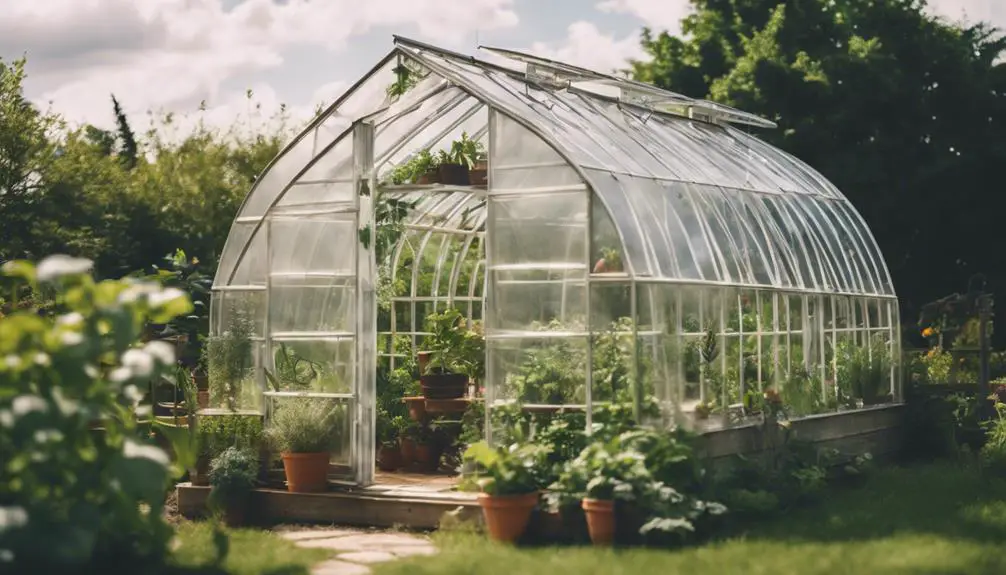
By incorporating hoop house greenhouse plans into your backyard design, you can create a versatile and space-efficient growing environment that's perfect for small-scale gardening projects and large-scale agricultural applications alike.
Hoop houses offer numerous benefits, including extended growing seasons, improved crop yields, and enhanced climate control.
One of the primary advantages of hoop house greenhouses is their adaptability to seasonal layouts. During the summer months, you can configure your hoop house to maximize ventilation and airflow, ensuring ideal temperatures for your plants. In the winter, you can adjust the layout to retain heat and protect your crops from harsh weather conditions.
To get the most out of your hoop house, consider implementing a seasonal rotation of crops. This approach allows you to take advantage of the unique benefits each season has to offer.
For example, you can plant cool-season crops like lettuce and kale in the early spring, followed by warm-season crops like tomatoes and peppers in the summer.
Greenhouse Location and Orientation
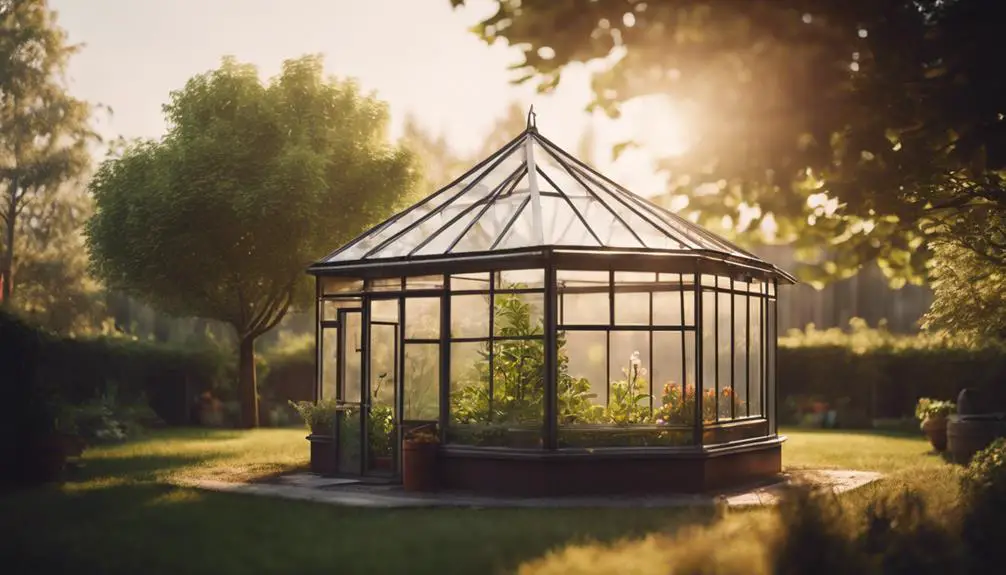
When selecting a location for your backyard greenhouse, you'll want to carefully consider the ideal spot that receives peak sunlight and minimizes shading.
You'll also need to think about wind direction, as a poorly situated greenhouse can be vulnerable to strong gusts.
Ideal Spot Selection
Carefully selecting a location for your greenhouse is crucial, as it directly impacts the structure's performance, with factors like sunlight, wind direction, and access to resources all playing critical roles in its overall success.
You'll want to conduct a thorough site analysis to identify the best spot in your yard. Start by creating a yard map, noting the location of existing features like trees, slopes, and water sources.
Consider the wind direction and how it may affect your greenhouse's stability and ventilation. You should also assess the soil type and drainage, as poor drainage can lead to waterlogged soil and root rot.
Additionally, think about accessibility, ensuring your greenhouse is close to a water source and electricity supply. By evaluating these factors, you'll be able to identify the ideal spot for your greenhouse, setting yourself up for success and maximizing its potential.
With a well-chosen location, you'll be able to create a thriving and efficient growing space that meets your needs and exceeds your expectations.
Sunlight and Shadow
You'll want to position your greenhouse to maximize sunlight exposure, as the ideal orientation can substantially impact the amount of light your plants receive, with south-facing slopes typically receiving the most direct sunlight throughout the day.
To perfect sunlight hours, conduct a shadow analysis to identify areas that receive the most direct sunlight and those that are shaded. This analysis will help you determine the best location and orientation for your greenhouse.
Consider the path of the sun throughout the day and year, taking into account any obstructions such as trees or buildings. A well-oriented greenhouse can receive up to 40% more sunlight than a poorly oriented one.
By positioning your greenhouse correctly, you'll be able to provide your plants with the light they need to thrive. Additionally, consider using movable shade cloth or louvers to control the amount of sunlight entering your greenhouse, especially during peak summer months.
Wind Direction Matters
Considering wind direction is pivotal when positioning your greenhouse, as it can markedly impact temperature regulation, humidity, and structural integrity.
You'll want to identify the prevailing wind patterns in your area and orient your greenhouse accordingly. A north-south orientation can help minimize wind-induced stress on the structure, while an east-west orientation can facilitate natural air circulation.
When evaluating your yard's wind patterns, take note of any obstacles that could disrupt airflow, such as trees, buildings, or fences.
You'll want to position your greenhouse in a way that avoids wind tunnel effects, which can create turbulent air circulation and put excessive pressure on the structure.
By understanding wind direction, you can design your greenhouse to take advantage of natural ventilation, reducing the need for mechanical systems and creating a more sustainable growing environment.
Insulation and Heating Options
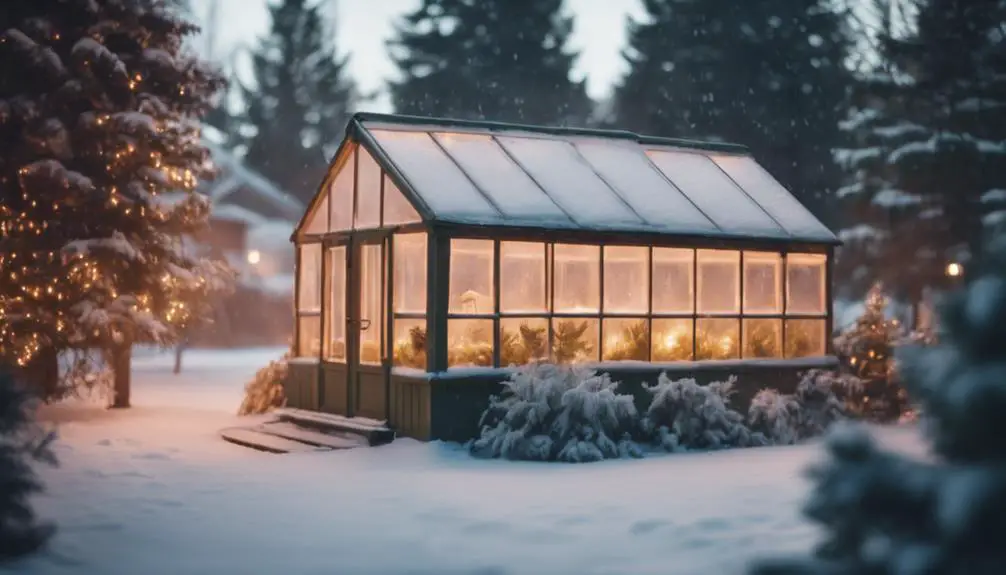
To guarantee ideal growing conditions and year-round productivity, your backyard greenhouse requires a well-planned insulation strategy and a reliable heating system to regulate internal temperatures.
Effective heat retention is vital, especially during colder months. You'll want to ponder various insulation types, such as fiberglass batts, foam board, or reflective insulation, to minimize heat loss. Insulation should be installed in the walls, floor, and ceiling to create a thermal envelope. Additionally, you can use thermal mass materials like concrete or brick to absorb and release heat.
When it comes to heating, you have several options. Electric heaters, such as infrared or ceramic heaters, are convenient and efficient. Alternatively, you can install a hydronic heating system, which uses hot water to warm the space. Solar-powered heaters are another eco-friendly option, harnessing the sun's energy to heat your greenhouse.
Whichever heating method you choose, make sure it's compatible with your insulation strategy to facilitate peak performance. By combining the right insulation and heating systems, you'll be able to maintain a consistent and ideal temperature for your plants to thrive.
Ventilation and Cooling Systems
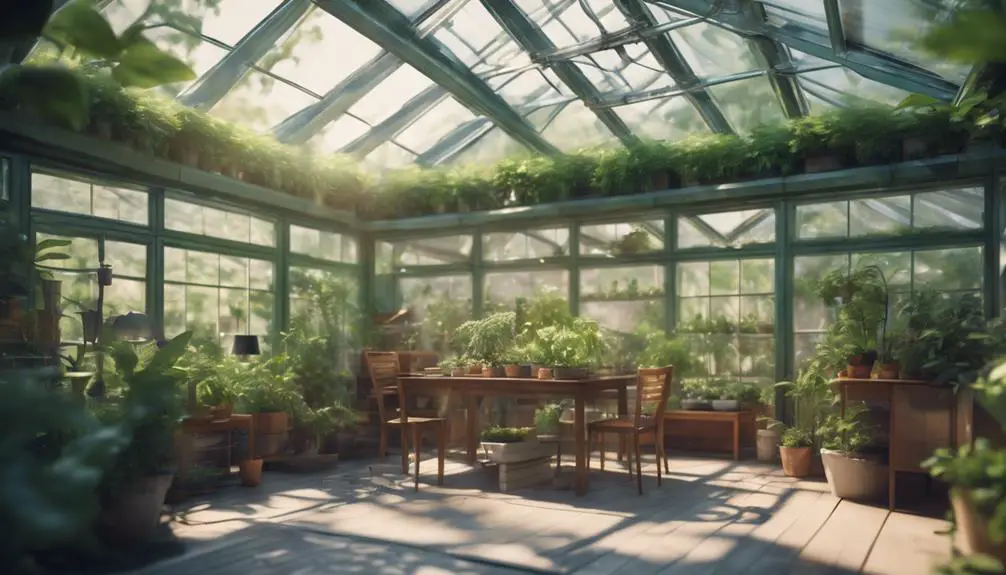
Proper ventilation and cooling systems are essential components of a well-functioning backyard greenhouse, as they help regulate internal temperatures, maintain air circulation, and prevent overheating during warm weather.
You'll want to verify that your greenhouse has adequate ventilation to remove excess heat and humidity, which can lead to plant diseases and pests.
One effective way to achieve this is by installing roof vents or windows that can be opened to allow hot air to escape.
Additionally, consider incorporating evaporative cooling systems, which use water to cool the air, reducing temperatures by up to 30°F.
This is particularly useful in dry climates where traditional air conditioning systems may not be effective.
Moreover, you can enhance air circulation by installing fans or misting systems, which can help distribute cool air more evenly throughout the greenhouse.
Irrigation and Watering Tips
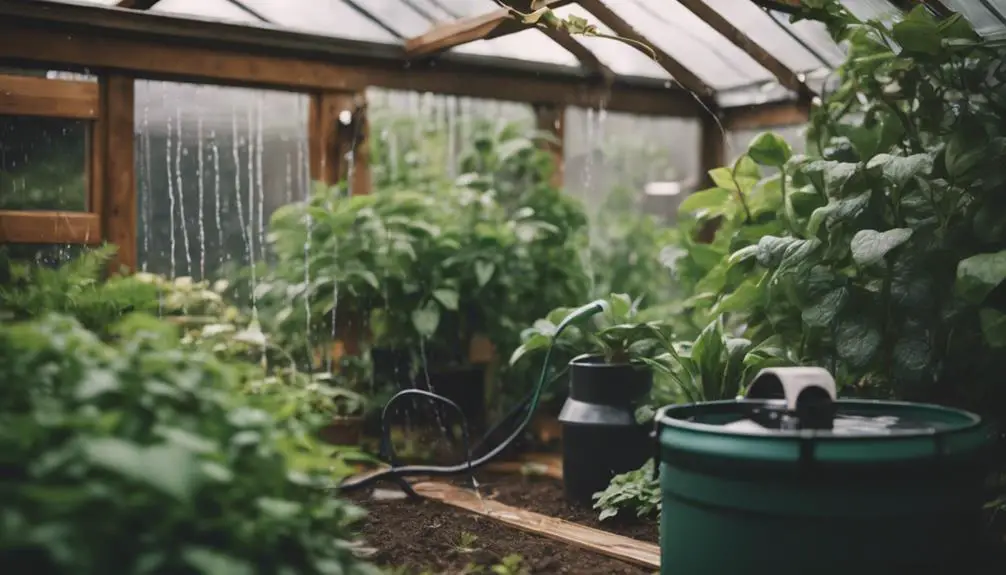
When designing your backyard greenhouse's irrigation system, you'll want to prioritize efficiency and precision.
By incorporating features like drip irrigation or soaker hoses, which deliver water directly to the roots of your plants, you can reduce evaporation and runoff.
This approach not only conserves water but also promotes healthy plant growth by providing a consistent supply of moisture.
To take it a step further, consider integrating a soil moisture sensor into your system, which can detect when the soil has reached ideal moisture levels, preventing overwatering and reducing waste.
Greenhouse Lighting Essentials
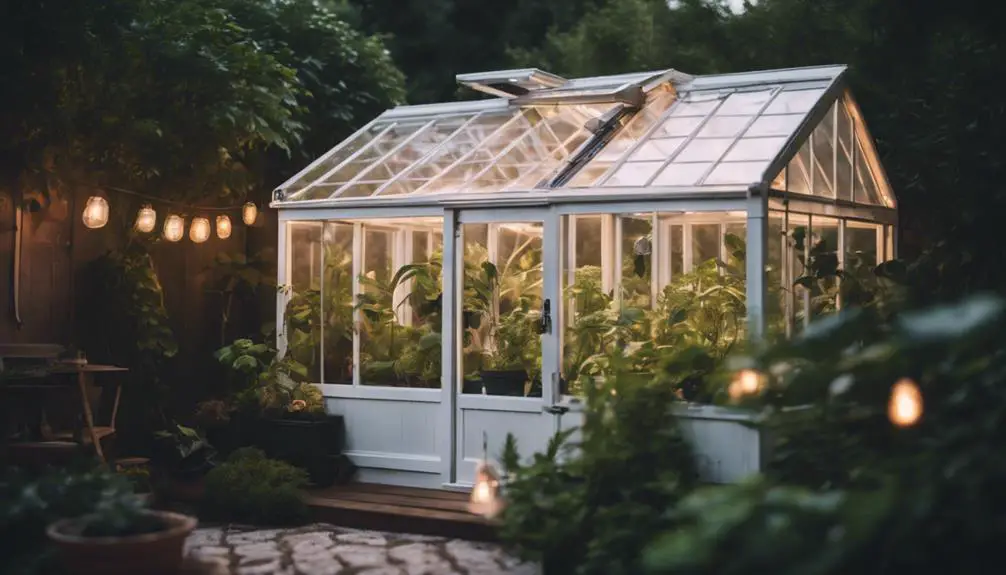
You'll need to guarantee your greenhouse's lighting system is optimized for plant growth, as the right spectrum and intensity can substantially impact photosynthesis and development.
This requires careful consideration of lighting timers, which allow you to simulate natural daylight cycles and promote healthy growth. By programming your lighting system to mimic the sun's natural rhythm, you'll encourage plants to thrive.
Spectrum control is another vital aspect of greenhouse lighting. Different plants respond better to specific wavelengths, so choosing the right lighting solutions is imperative for catering to your plants' unique needs.
For example, blue spectrum lighting can enhance vegetative growth, while red spectrum lighting promotes flowering and fruiting. By incorporating adjustable spectrum control into your lighting system, you'll be able to fine-tune the light to match your plants' requirements.
When selecting lighting fixtures, look for energy-efficient options with high PAR (photosynthetic active radiation) values. These will provide the necessary intensity and spectrum for ideal plant growth.
Creative Greenhouse Interior Design
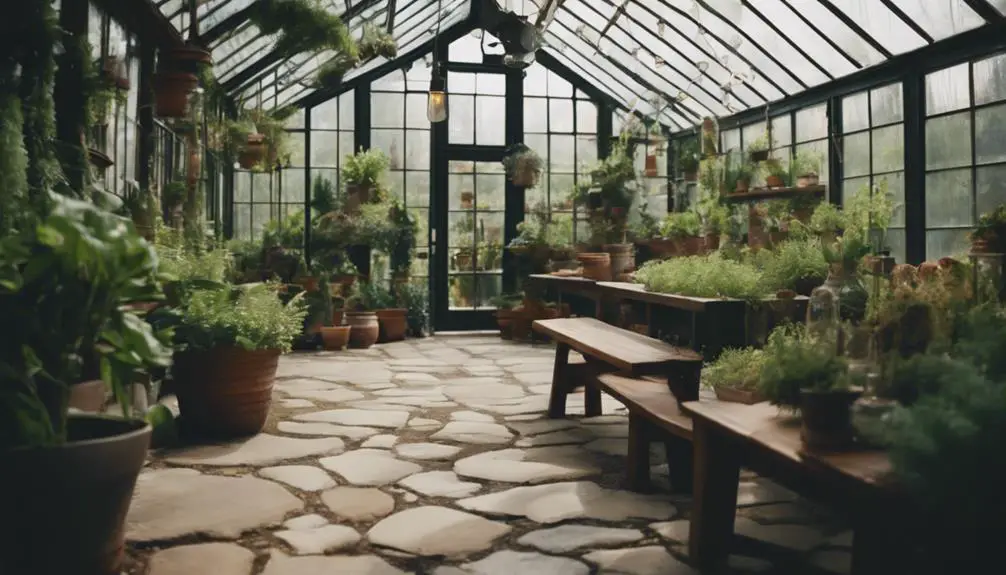
Designing a functional and visually appealing interior space is crucial to creating a perfect growing environment, as a well-planned layout allows for efficient plant care, maximizes space, and enhances the overall greenhouse experience.
You'll want to ponder the specific needs of the plants you're growing, as well as your personal preferences, when selecting materials, colors, and textures.
To make the most of your space, incorporate vertical elements like plant walls or living walls, which not only add visual interest but also increase growing capacity. Vertical gardens, either freestanding or attached to walls, can be used to grow vining plants, herbs, or even microgreens.
Ponder using trellises, arbors, or obelisks to provide support for climbing plants, adding an extra layer of depth to your design.
Don't forget to incorporate functional elements like shelving, benches, and irrigation systems to guarantee easy maintenance and care.
Year-Round Growing Strategies

To maximize your greenhouse's potential, adopt a year-round growing strategy that takes into account factors like climate, light, and temperature to certify a constant harvest.
You'll need to ponder crop selection, soil conditioning, and climate control to create a perfect environment for your plants.
In regions with distinct seasons, design a rotation of cool-season and warm-season crops to secure continuous production. For example, plant cool-season crops like kale and broccoli in the winter, and warm-season crops like tomatoes and peppers in the summer.
Implement advanced climate control techniques, such as heating and cooling systems, to regulate temperature and humidity levels.
This will enable you to grow a wide range of crops, regardless of the external climate.
Additionally, focus on soil conditioning by incorporating organic matter, fertilizers, and pest management strategies to maintain soil health and fertility.
Frequently Asked Questions
Can I Build a Greenhouse With Recycled Plastic Bottles?
You can collect and clean plastic bottles, then cut and assemble them into a sturdy structure, using eco-friendly adhesives and plastic alternatives, to create a unique, sustainable greenhouse that reduces waste and showcases innovation.
How Do I Prevent Pests From Entering My Greenhouse?
To prevent pests from entering your greenhouse, you'll implement effective pest control methods, such as fine-mesh screens, sticky traps, and natural barriers like neem oil and diatomaceous earth to deter unwanted visitors and protect your crops.
Are Greenhouses Suitable for Growing Mushrooms?
You can successfully grow various mushroom varieties in a controlled environment, leveraging climate control to replicate ideal conditions, but it's vital to guarantee precise temperature, humidity, and light management to foster peak mycelium growth and fruiting.
Can I Use a Greenhouse for Raising Chickens?
You can raise chickens in a controlled environment by utilizing a greenhouse, ensuring proper Coop ventilation and implementing efficient Chicken feeders, but consider climate control, predator protection, and local regulations before integrating poultry into your greenhouse setup.
Do Greenhouses Require Special Electrical Installations?
When building a structure that relies on electricity, you'll need to guarantee you meet local electrical codes, which may require special permits and wiring safety measures to prevent hazards, like overheating or electrical shock.
Conclusion
By incorporating these backyard greenhouse ideas, you'll be well on your way to creating a peak growing environment.
Remember to balance natural light, climate control, and efficient systems to guarantee year-round harvesting.
With careful planning, your DIY greenhouse will thrive, providing a haven for your plants and a sense of accomplishment for you.
Now, get started and watch your outdoor space transform into a lush oasis, perfect for growing and enjoying your favorite fruits, vegetables, and flowers.




